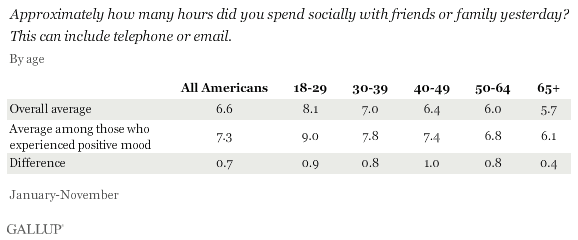WASHINGTON, D.C. -- The more time Americans spend socially with family and friends, the more likely they are to report enjoyment and happiness in their lives without a lot of stress and worry. Overall, Americans' self-reported mood improves with each hour of social time they spend in a day, up to about seven hours. Though the relationship is present among all age groups, Americans aged 65 and older are more likely than their younger counterparts to maintain a positive mood with fewer hours of social time.

The percentage of seniors reporting a lot of enjoyment and happiness without a lot of stress and worry increases more than 20 percentage points between those with no hours of social time the previous day and those with three hours. Among adults younger than 30, it takes more than six hours of social time to see as much of an increase in positive mood.
Among Americans overall who report less than one hour spent socially the previous day, 30% say they experienced a lot of enjoyment and happiness without a lot of stress and worry that day. That figure rises to a majority among those who report at least six hours of social time before leveling off. Americans 65 and older, however, are almost as likely to be in a positive emotional state with three hours of social time as they are with seven or eight hours.
That is good news because the average amount of social time Americans get drops considerably with age. Adults younger than 30 report spending an average of 8.1 hours socializing the previous day, compared with 5.7 hours among those 65 and older. However, older Americans who felt enjoyment and happiness without a lot of worry and stress the previous day averaged 6.1 hours. In terms of its relationship to positive mood, the social time "shortfall" is actually lower among seniors than among younger Americans.

Implications
As a recent analysis of Gallup-Healthways Well-Being Index tracking surveys demonstrated, Americans' emotional well-being rises significantly after about age 60. This does not seem to simply be an effect of retirement; in fact, seniors are about as likely to experience enjoyment and happiness without a lot of stress and worry whether they are working full time (61%) or are out of the workforce (63%). This greater emotional resilience may help seniors as they enter life stages when they are less likely to have children at home or to spend all day with coworkers at a full-time job.
This is not to say social interactions are not an important component of well-being for everyone. Research has demonstrated the benefits of social activity to overall health and even mental acuity among seniors. However, it may be comforting to know that Americans' emotional state does not necessarily suffer as the average time they spend daily in the company of others declines with age.
About the Gallup-Healthways Well-Being Index
The Gallup-Healthways Well-Being Index tracks well-being in the U.S., U.K., and Germany and provides best-in-class solutions for a healthier world. To learn more, please visit well-beingindex.com.
Survey Methods
Results are based on telephone interviews conducted as part of the Gallup-Healthways Well-Being Index survey Jan. 2-Nov. 28, 2011, with a random sample of 31,486 adults, aged 18 and older, living in all 50 U.S. states and the District of Columbia, selected using random-digit-dial sampling.
For results based on the total sample of national adults, one can say with 95% confidence that the maximum margin of sampling error is ±1 percentage point. Subgroups have a maximum margin of sampling error of ±7.5 percentage points.
Interviews are conducted with respondents on landline telephones and cellular phones, with interviews conducted in Spanish for respondents who are primarily Spanish-speaking. Each sample includes a minimum quota of 400 cell phone respondents and 600 landline respondents per 1,000 national adults, with additional minimum quotas among landline respondents by region. Landline telephone numbers are chosen at random among listed telephone numbers. Cell phone numbers are selected using random-digit-dial methods. Landline respondents are chosen at random within each household on the basis of which member had the most recent birthday.
Samples are weighted by gender, age, race, Hispanic ethnicity, education, region, adults in the household, and phone status (cell phone only/landline only/both, cell phone mostly, and having an unlisted landline number). Demographic weighting targets are based on the March 2010 Current Population Survey figures for the aged 18 and older non-institutionalized population living in U.S. telephone households. All reported margins of sampling error include the computed design effects for weighting and sample design.
In addition to sampling error, question wording and practical difficulties in conducting surveys can introduce error or bias into the findings of public opinion polls.
For more details on Gallup's polling methodology, visit www.gallup.com.
